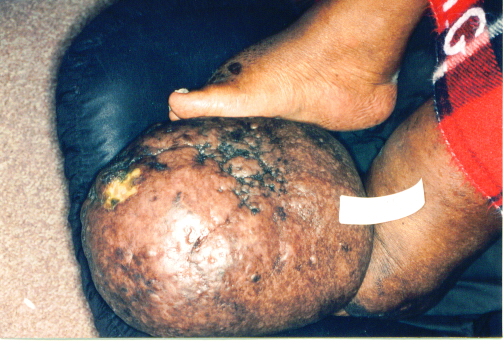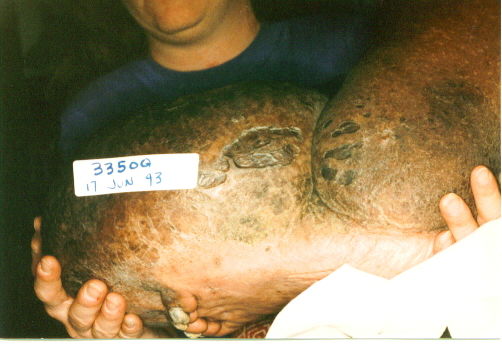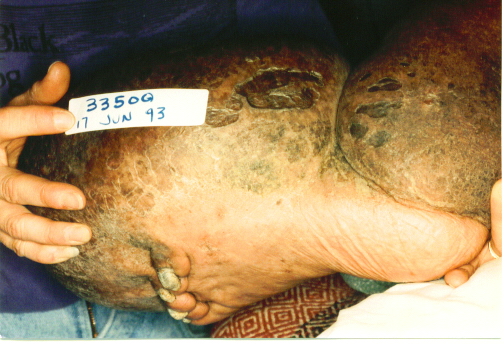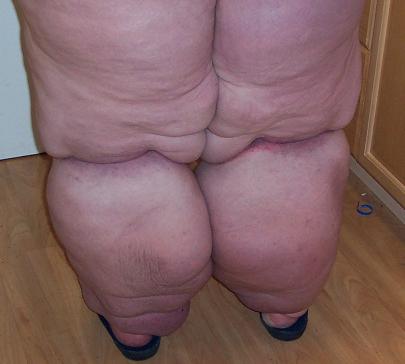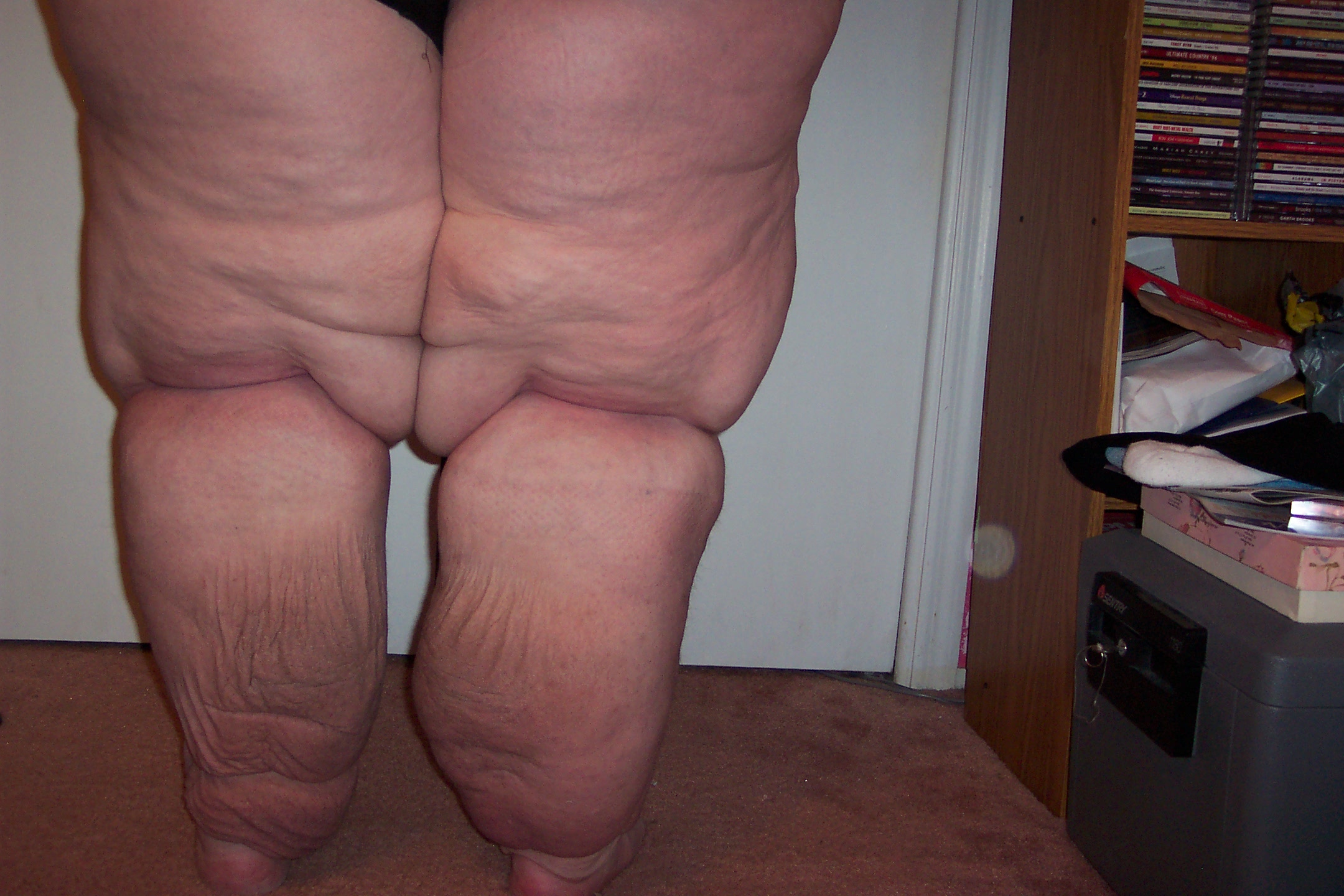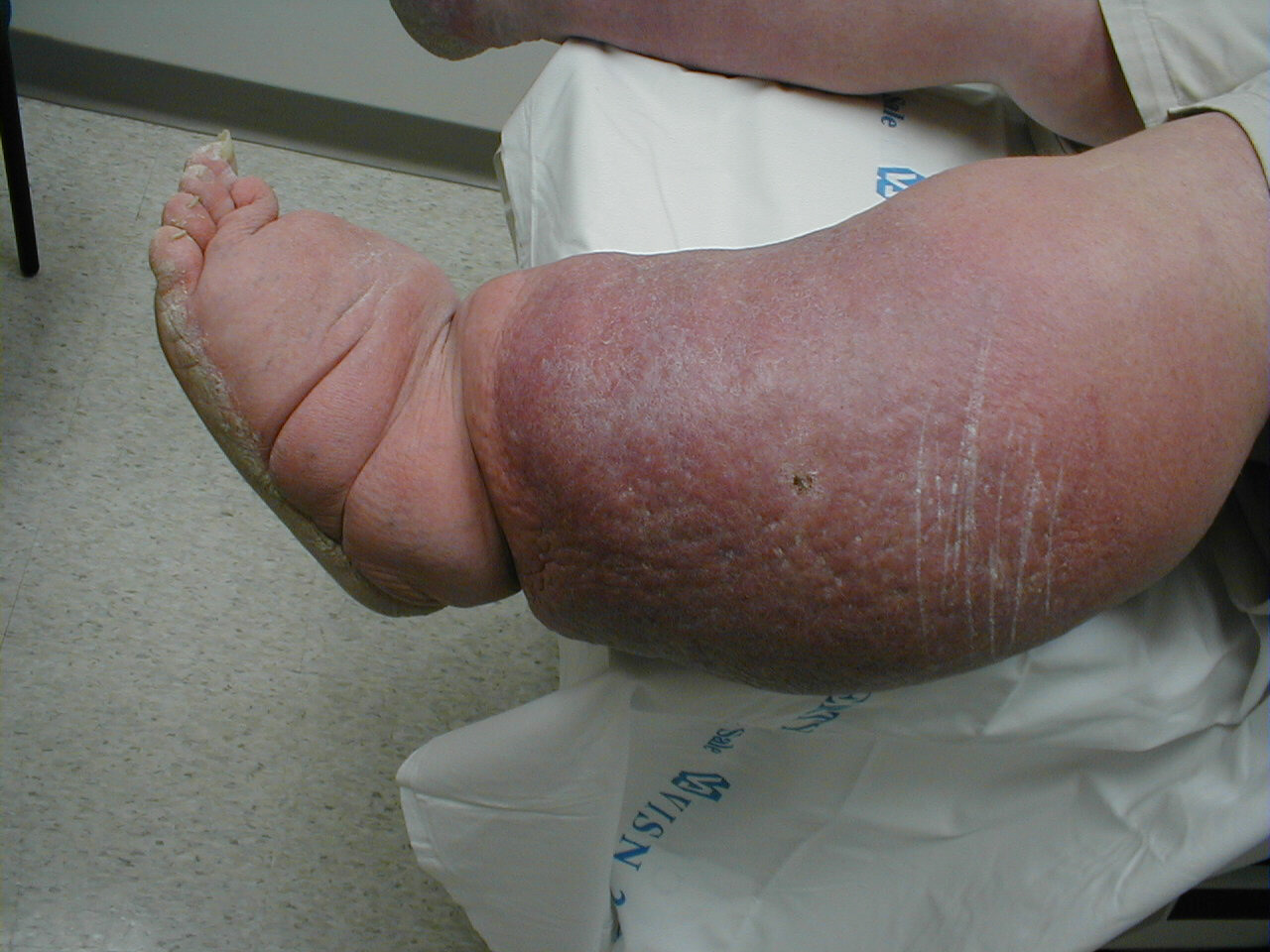Lymphedema
| Lymphedema | |
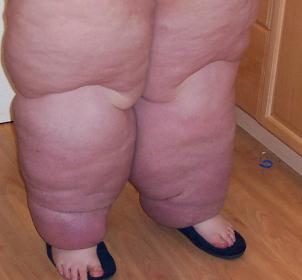 | |
|---|---|
| ICD-10 | I89.0, I97.2, Q82.0 |
| ICD-9 | 457.0, 457.1, 757.0 |
| DiseasesDB | 7679 |
| eMedicine | med/2722 |
| MeSH | D008209 |
|
WikiDoc Resources for Lymphedema |
|
Articles |
|---|
|
Most recent articles on Lymphedema |
|
Media |
|
Evidence Based Medicine |
|
Clinical Trials |
|
Ongoing Trials on Lymphedema at Clinical Trials.gov Clinical Trials on Lymphedema at Google
|
|
Guidelines / Policies / Govt |
|
US National Guidelines Clearinghouse on Lymphedema
|
|
Books |
|
News |
|
Commentary |
|
Definitions |
|
Patient Resources / Community |
|
Patient resources on Lymphedema Discussion groups on Lymphedema Patient Handouts on Lymphedema Directions to Hospitals Treating Lymphedema Risk calculators and risk factors for Lymphedema
|
|
Healthcare Provider Resources |
|
Causes & Risk Factors for Lymphedema |
|
Continuing Medical Education (CME) |
|
International |
|
|
|
Business |
|
Experimental / Informatics |
| Cardiology Network |
 Discuss Lymphedema further in the WikiDoc Cardiology Network |
| Adult Congenital |
|---|
| Biomarkers |
| Cardiac Rehabilitation |
| Congestive Heart Failure |
| CT Angiography |
| Echocardiography |
| Electrophysiology |
| Cardiology General |
| Genetics |
| Health Economics |
| Hypertension |
| Interventional Cardiology |
| MRI |
| Nuclear Cardiology |
| Peripheral Arterial Disease |
| Prevention |
| Public Policy |
| Pulmonary Embolism |
| Stable Angina |
| Valvular Heart Disease |
| Vascular Medicine |
Editors-in-Chief: Benoit Blondeau, M.D. [1]; C. Michael Gibson, M.S., M.D. [2]
Please Join in Editing This Page and Apply to be an Editor-In-Chief for this topic:
There can be one or more than one Editor-In-Chief. You may also apply to be an Associate Editor-In-Chief of one of the subtopics below. Please mail us [3] to indicate your interest in serving either as an Editor-In-Chief of the entire topic or as an Associate Editor-In-Chief for a subtopic. Please be sure to attach your CV and or biographical sketch.
Lymphedema, also spelled lymphoedema, also known as lymphatic obstruction, is a condition of localized fluid retention caused by a compromised lymphatic system. The lymphatic system (often referred to as the body's "second" circulatory system) collects and filters the interstitial fluid of the body. Lymphedema has been barely recognized as being a serious health problem; however, this is slowly changing due to education and awareness. The danger with lymphedema comes from the constant risk of developing an uncontrolled infection in the affected limb. Still, physicians and medical staff who practice in fields where this disease is uncommon may fail to correctly diagnose the condition due to the apparent lack of information regarding this disease.
Pathophysiology
Lymphedema (also see Elephantiasis) may be inherited (primary) or caused by injury to the lymphatic vessels (secondary). It is most frequently seen after lymph node dissection, surgery and/or radiation therapy, in which damage to the lymphatic system is caused during the treatment of cancer, most notably breast cancer. In many cancer patients this condition does not develop until months or even years after their therapy has concluded. Lymphedema may also be associated with accidents or certain diseases or problems that may inhibit the lymphatic system from functioning properly. In tropical areas of the world, a common cause of secondary lymphedema is filariasis, a parasitic infection.
While the exact cause of primary lymphedema is still unknown, it generally occurs due to poorly-developed or missing lymph nodes and/or channels in the body. Lymphedema may be present at birth, develop at the onset of puberty (praecox), or not become apparent for many years into adulthood (tarda). Some cases of lymphedema may be associated with other vascular abnormalities. In the lower extremity it will be unilateral or bilateral. If it is bilateral, one leg may be worse than the other.
Lymphedema affects both men and women. In women, it is most prevalent in the upper limbs after breast cancer surgery and lymph node dissection, occurring in the arm on the side of the body in which the surgery is performed. It may also occur in the lower limbs or groin after surgery for colon, ovarian or uterine cancer in which removal of lymph nodes is required. In men, lower-limb primary lymphedema is most common, occurring in one or both legs. Surgery and/or treatment for prostate, colon and testicular cancers may result in secondary lymphedema, particularly where lymph nodes have been removed or damaged.
The onset of secondary lymphedema in patients who have had cancer surgery has also been linked to aircraft flight (likely due to decreased cabin pressure). For breast cancer survivors, wearing a prescribed and properly-fitted low-compression sleeve and gauntlet may help decrease swelling during flight.
Some cases of lower-limb lymphedema have been associated with the use of Tamoxifen, due to the blood clots and deep vein thrombosis (DVT) that can be caused by this medication.
Staging and severity
Stages
Whether primary or secondary, lymphedema develops in a number of stages, from mild to severe. The stages were defined in the following manner by the Fifth WHO Expert Committee on Filariasis:[1][2]
- Stage 0 (latent): The lymphatic vessels have sustained some damage which is not yet apparent. Transport capacity is still sufficient for the amount of lymph being removed. Lymphedema is not present.
- Stage 1 (spontaneously reversible): Tissue is still at the "pitting" stage -- when pressed by the fingertips, the affected area indents and holds the indentation. Usually upon waking in the morning, the limb or affected area is normal or almost normal in size.
- Stage 2 (spontaneously irreversible): The tissue now has a spongy consistency and is "non pitting" -- when pressed by the fingertips, the tissue bounces back without any indentation. Fibrosis found in Stage 2 Lymphedema marks the beginning of the hardening of the limbs and increasing size.
- Stage 3 (lymphostatic elephantiasis): At this stage, the swelling is irreversible and usually the limb(s) or affected area is very large. The tissue is hard (fibrotic) and unresponsive; some patients consider undergoing reconstructive surgery called "debulking". This remains controversial, however, since the risks may outweigh the benefits, and the further damage done to the lymphatic system may in fact make the lymphedema worse.
Grades
Lymphedema can also be categorized by its severity (usually referenced to a healthy extremity):
- Grade 1 (mild edema): Lymphedema involves the distal parts such as a forearm and hand or a lower leg and foot. The difference in circumference is less than 4 centimeters, and other tissue changes are not yet present.
- Grade 2 (moderate edema): Lymphedema involves an entire limb or corresponding quadrant of the trunk. Difference in circumference is more than 4 but less than 6 centimeters. Tissue changes, such as pitting, are apparent. The patient may experience erysipelas.
- Grade 3a (severe edema): Lymphedema is present in one limb and its associated trunk quadrant. The difference in circumference is greater than 6 centimeters. Significant skin alterations, such as cornification or keratosis, cysts and/or fistulae, are present. Additionally the patient may experience repeated attacks of erysipelas.
- Grade 3b (massive edema): The same symptoms as Stage 3a except that two or more extremities are affected.
- Grade 4 (gigantic edema): Also known as elephantiasis. In this stage of lymphedema, the affected extremities are huge due to almost complete blockage of the lymph channels. Elephantiasis may also affect the head and face.
Diagnosis, assessment and monitoring
The diagnosis or early detection of lymphedema is difficult. The first signs may be subjective observations such as "my arm feels heavy" or "I have difficulty these days getting rings on and off my fingers". These may be symptomatic of early stage of lymphoedema where accumulation of lymph is mild and not detectable by any difference in arm volume or circumference (see severity above). As lymphedema develops further then definitive diagnosis is commonly based upon an objective measurement of difference between the affected or at-risk limb at the opposite unaffected limb, e.g. in volume or circumference. Unfortunately, there is no generally accepted world-wide criterion of difference definitively diagnostic although a volume of difference of 200 ml between limbs or a 4 cm (at a single measurement site or set intervals along the limb) is often used. Recently the technique of bioimpedance measurement (a method that measures the amount of fluid in a limb) has been shown to have greater sensitivity than these existing methods and holds promise as a simple diagnostic and screening tool.[3] Impedance analysers specifically designed for this purpose are now commercially available.
Similarly assessment and monitoring of lymphedema progression or its response to treatment is usually based on the changes in volume, circumference or impedance over time. [4]
Diagnostic Findings
Presented here is a case of unilateral hereditary lymphedema which had been present for 25 years without treatment:
-
Comparison of normal and swollen limb
-
Size of swollen foot, toes underneath
-
Another view of lymphedemic foot
-
Foot and leg (held vertically)
Presented here is a case of combined primary lymphedema and lipedema(Stage 3) before and after treatments: Below photos courtesy of Amy's Lymphedema Story
-
Stage 3 lymphedema front view before treatments
-
Stage 3 lymphedema back view before treatments
-
Stage 3 lymphedema front view after treatments, 65 pounds lost in 14 days
-
Stage 3 lymphedema back view after treatments, 65 pounds lost in 14 days
Other Examples
Symptoms
Symptoms may include severe fatigue, a heavy swollen limb or localized fluid accumulation in other body areas, including the head or neck, discoloration of the skin overlying the lymphedema, and eventually deformity (elephantiasis).
Lymphedema should not be confused with edema arising from venous insufficiency, which is not lymphedema. However, untreated venous insufficiency can progress into a combined venous/lymphatic disorder which is treated the same way as lymphedema (see Treatment below).
Treatment
The most common and accepted treatments of choice for lymphedema are Sequential Gradient Pump Therapy and Complete Decongestive Therapy (CDT).
Complete Decongestive Therapy (CDT)
CDT consists of manual lymphatic drainage (MLD), short stretch compression bandaging, therapeutic exercise, and skin care. MLD was pioneered by Dr. Emil Vodder in the 1930s for the treatment of chronic sinusitis and other immune disorders, and is now recognized along with pneumatic pumps, and compression sleeves, as a primary tool in lymphedema management. Therapists can today receive certification through special classes conducted by various organizations specializing in MLD.
Initially, CDT involves frequent visits to a certified therapist with a doctor's prescription. Once the lymphedema is reduced, increased patient participation is required for ongoing care, along with the use of compression garments to further reduce the swelling.
Sequential Gradient Pump Therapy
Sequential Gradient Pump Therapy has been utilized for over 30 years throughout the world. Lympha-Press helped pioneer and perfect this technology with by utilizing a 12 chambered pneumatic sleeve with overlapping cells, to gently move the lymph fluid. There are several other manufacturers of these devices such as Bio Compression Systems, and Wright Linear. All of these devices are recognized treatments and approved by Medicare and most insurance plans in the USA. Patients may often receive treatment on a pump for 10-15 minutes before an MLD session to help break up fibrotic (hard) tissue. By softening or breaking up the fibrosis, the MLD Therapist can be even more effective with the given treatment. After completion of the appropriate number of MLD sessions, some patients will benefit from a home use of a sequential pump. A recent Stanford University medical studyshowed that patients receiving the combined modalities of MLD/CDT and pneumatic pumping had a greater overall reduction in limb volume than patients receiving only MLD/CDT.[5]
The MLD component of treatment consists of gentle, rhythmic massaging of the skin to stimulate the flow of lymph and its return to the blood circulation system. In the blood’s passage through the kidneys, the excess fluid is filtered out and eliminated from the body through urination. The treatment is very comfortable and nonaggressive. A typical session will involve drainage of the neck, trunk, and involved extremity (in that order), and lasts approximately 40 to 60 minutes, depending on the severity and extent of the lymphedema.
Compression bandaging
Compression bandaging, also called wrapping, is the application of several layers of padding and short-stretch bandages to the involved areas. Short-stretch bandages are preferred over long-stretch bandages (such as those normally used to treat sprains), as the long-stretch bandages cannot produce the higher tension necessary to safely reduce Lymphedema and may in fact end up producing a tourniquet effect. During activity, whether exercise or daily activities, the short-stretch bandages enhance the pumping action of the lymph vessels by providing increased resistance for them to push against. This encourages lymphatic flow and helps to soften fluid-swollen areas.
Therapeutic exercise
In addition, specific therapeutic exercise while compression bandaging is worn is a valuable part of therapy, not only because it aids in the elimination of excess fluid, but also because some patients with chronic lymphedema or large, swollen areas will have poor strength or range of movement. Pool therapy using manual lymp drainage techniques will help to keep the tissue soft and assist in moving the lymphedema fluid. These patients benefit from exercise prescribed specifically for them by their physician to help improve their function and comfort.
Skin care
Skin care is an important component of CDT. People with lymphedema or who have had lymph nodes removed are at a higher risk for infections of the affected areas, and so need to be taught a specific regimen of thorough but gentle cleansing followed by moisturizing in order to keep the skin in the best health possible. Teaching higher risk sufferers about the signs and symptoms of infections is also important, since awareness is the key to early identification and treatment. Untreated infections can further damage an already impaired lymphatic system and lead to more severe lymphedema and skin ulcers.
Skin care
Compression pumps are often used in the treatment of lymphedema, but special care needs to be taken to ensure that the involved trunk quadrant is properly treated with manual lymphatic drainage before the application of a compression pump. If adequate treatment of the trunk is not carried out beforehand, the edema may be pushed into the upper portion of the arm or leg, or into the genitals. If a patient's lymphedema worsens during a course of compression pump therapy, reassessment for adequate trunk MLD is necessary. However, newer compression pump garments provide compression well into the trunk and/or abdomen and groin areas. Although very beneficial, many patients find it inconvenient or expensive to attend regular MLD treatment sessions. A 2002 Stanford University article suggests that for patients with upper-limb lymphedema, those who received both MLD and compression pump therapy experienced greater overall limb reduction.
Even after MLD, the patient may only be bandaging or receiving compression up to the axilla (arm pit area) or groin. Unless the patient is monitored during post MLD self bandaging, there is a possibility of the lymph fluid pooling in the truncal regions. For this reason, reassessment for adequate trunk MLD may need to be re-evaluated as necessary.
Kinesio Taping
A new adjunct treatment is being taught to therapists utilizing a special type of tape called Kinesio Taping. It is used to help soften edemas.
Surgical techniques
Surgical techniques for correcting lymphedema may be excisional or physiological. Excisional techniques include:
- Circumferential excision of the lymphedematous tissue followed by skin grafting (Charles technique); longitudinal removal of the affected segment of skin and subcutaneous tissue and primary closure (Homans technique); excision of subcutaneous tissue and tunneling of a dermal flap through the fascia into a muscular compartment of the leg (Thompson technique).
Physiological techniques include:
- Lympholymphatic anastomosis (autologous lymphatic grafts to bridge obstructed lymphatic segments); lymphovenous shunt (anastomosis of lymphatic channels to veins); lymphangioplasty enteromesenteric flap omental transfer (pedicled portion of omentum transposed to the affected limb).
Complications
When the lymphatic impairment becomes so great that the lymph fluid exceeds the lymphatic system's ability to transport it, an abnormal amount of protein-rich fluid collects in the tissues of the affected area. Left untreated, this stagnant, protein-rich fluid causes tissue channels to increase in size and number, reducing the availability of oxygen. This interferes with wound healing and provides a rich culture medium for bacterial growth that can result in infections: cellulitis, lymphangitis, lymphadenitis, and in severe cases, skin ulcers. It is vital for lymphedema patients to be aware of the symptoms of infection and to seek treatment at the first signs, since recurrent infections, in addition to their inherent danger, further damage the lymphatic system and set up a vicious circle.
Very rarely, in certain exceptionally severe cases, lymphedema untreated over many years can lead to a form of cancer known as Lymphangiosarcoma.
Since lymphedema is disfiguring, causes difficulties in daily living and can lead to lifestyle becoming severely limited, it may also result in psychological distress.
References
- ↑ "Lymphatic filariasis: the disease and its control. Fifth report of the WHO Expert Committee on Filariasis". World Health Organization technical report series. 821: 1–71. 1992. PMID 1441569.
- ↑ http://whqlibdoc.who.int/hq/2001/WHO_CDS_CPE_CEE_2001.26a.pdf.
- ↑ "Mary Ann Liebert, Inc. - Lymphatic Research and Biology - 4(1):51". Retrieved 2007-11-01.
- ↑ Benoit Blondeau; Lawrence L Tretbar; Morgan, Cheryl E.; Simon J. Simonian (2006). Lymphedema: Diagnosis and Treatment. Springer Verlag. ISBN 1-84628-548-8.
- ↑ Szuba A, Achalu R, Rockson SG (2002). "Decongestive lymphatic therapy for patients with breast carcinoma-associated lymphedema. A randomized, prospective study of a role for adjunctive intermittent pneumatic compression". Cancer. 95 (11): 2260–7. doi:10.1002/cncr.10976. PMID 12436430.
External links
General Links
- "Lymphology: An Emerging Field of U.S. Medicine" - Annual Conference 2006 Kansas City, October http://www.lymphology.org
- Schingale, Franz-Josef, "Lymphoedema, Lipoedema, Diagnosis and Therapy: A Guide for Those Affected," 2003, Hannover: Schlütersche GmbH & Co. KG. link
- LymphSource.com -- On-line Lymphedema Resource Directory
- British Lymphology Society
- American Society of Lymphology
- MedlinePlus Encyclopedia 001117
- Association of manual lymphatic drainage practitioners
- MSU
- National Lymphedema Network
- Lymphology Association of North America (LANA)
Lymphedema Patient Websites
- LymphedemaTalk - A forum for lymphedema information and help.
- Lymphedema Discussion Group on Yahoo!Groups
- Lymphedema Art Journal
- Lymphedema People
- Lymphnotes - Site that gives useful information to people with lymphedema
- Lymphoedema Support Network (UK)
- L-Team
Template:Congenital malformations and deformations of integument Template:SIB
ast:Linfedema
de:Lymphödem
nl:Lymfoedeem
